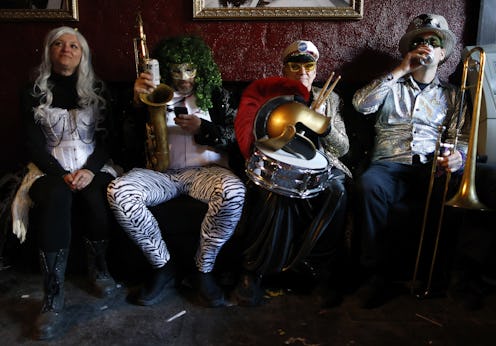Life
Lesser-Known Mardi Gras Facts And Traditions

Think you know everything there is to know about Mardi Gras? Think again. The 300-plus-year-old holiday is one of the longest, more widely celebrated holidays across the world, bringing together countries with vastly different cultures and backgrounds to celebrate in their own unique ways. While there's only one original Fat Tuesday, there are many quirks and traditions that contribute to the makings of a blowout Carnival celebration.
With centuries of history, the Mardi Gras holiday has deep-seated roots in southern culture and the Christian religion, with new traditions arising year after year. Whether you're native to New Orleans, host your own celebration in Northeast USA, or you're patiently awaiting the start of the holiday in Aussieland, the Mardi Gras holiday surely holds distinct meaning from where you stand.
Below are seven of the lesser-known Mardi Gras facts and traditions, which add to the value of this weeks-long holiday that brings people together from all over the world.
Mardi Gras Ladders Line The Streets At Parade Time
Colorful, elaborate ladders have lined the streets of New Orleans during Mardi Gras parades for decades. The tradition caters to the younger audience attending the carnival for pure entertainment, to gawk and stare at the outlandish characters passing by on float after float.
Since kids are often too short in stature to catch the parade from standing level, the ladder is equipped with a small ledge at its peak, making for the best seat in the house. It's not unusual to see rows of small children adorning the tops of ladders along the streets of New Orleans during Mardi Gras.
Mardi Gras Is A Global Holiday Celebration
Though the biggest carnival originated and takes place in New Orleans, Louisiana, several countries all over the world participate in the holiday with their own unique traditions. In Canada, the UK, Australia, New Zealand, and Ireland, for instance, "Fat Tuesday" is instead dubbed "Pancake Day," which calls for eating a surplus of pancakes to celebrate.
Better known as "Carnival" the world over, countries like Belgium and France use the holiday as a celebration to welcome spring with symbolic flowers and seasonal fruits. Other countries stay true to their respective cultures and throw massive parties in the name of the holiday.
Mardi Gras Has Roots In The Christian Religion
The Mardi Gras season technically begins on the Christian holiday of Jan. 6 known as Epiphany, aka "Three Kings Day" or "The Twelfth Day." The day honors the wise men and bringing of gifts to baby Jesus.
The traditional King Cake carries on this religious token with a baby Jesus figurine baked into it. Whoever takes a bite of cake with the figurine is believed to have good luck for the rest of the year – or just buy the next cake!
Mardi Gras also takes place the Tuesday before Ash Wednesday, which marks the onset of Lent, the 40-day Christian holiday. For 40 days, Christians voluntarily abstain from a number of vices and privileges as a symbol of sacrifice. Mardi Gras, in turn, is considered the last chance to participate in absolute gluttony and indulge in the variety of foods unique to the Carnival celebration.
Mardi Gras Beads Were Originally Made Of Glass
First introduced by the King of Mardi Gras in 1872, beads were made of glass and intended to be passed to Carnival-goers exhibiting the most spirit through the colors of purple, green, and gold. Obviously, glass beads weren't exactly the best option for throwing mass amounts into crowds of people, so it wasn't until the introduction of plastic beads that the tradition became commonplace.
In more recent years, "winning" Mardi Gras beads has been associated with a different showing of spirit, as in rowdy behavior and flashing the passing parade floats.
There Is An Official King & Queen Of Mardi Gras
Mardi Gras Parade Krewes are organizations, or clubs of sorts, which contribute to the planning of the Mardi Gras Carnival and parade. Some krewes have been around for decades, while others are just a few years old.
The Rex Krewe is one of the oldest organizations, which is responsible for coining some of the most recognizable Mardi Gras traditions, like the use of purple which represents justice, green to symbolize faith, and gold as a showing of power. This krewe also takes charge of selecting Carnival royalty, namely the King of Mardi Gras, better known as "Rex."
Masks Are Required By Law On Floats
First implemented as a way of evading social constraints and stereotypes, masks provide Carnival-goers the freedom to be whomever they want to be and socialize with whomever they wish. It's been a tradition that has held strong and added to the excitement of the celebration over the years, welcoming all Carnival-goers to wear a mask on Fat Tuesday. By law, however, float riders are required to wear masks throughout the parade.
Mardi Gras Flambeaux Originated As More Than Entertainment
The flame-torch tradition, also known as Flambeaux, was originally intended to light the streets so Carnival-goers could see the parade and festivities happening long into the nighttime. At the onset of Mardi Gras, slaves and free African-Americans were paid a very small stipend to carry the torches, as festival-goers threw coins at them for being a source of light.
Today, though the tradition continues, the flamethrowers serve as pure entertainment, dancing their way through the streets, spinning large matchsticks for the crowds in awe.